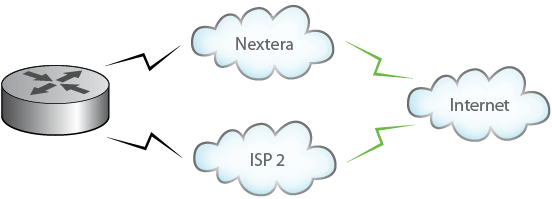
BGP Multi Homing | Redundant Internet Connection Providers Minnesota
With the multitude of mission-critical applications, e-commerce, VPNs, constant Internet connectivity has become vital to the success of businesses; making a redundant connection a necessity to ensure the availability of those applications.
BPG is one of the key tools for achieving Internet connection redundancy. With BGP, Nextera provides one of your two Internet feeds, which is called multi-homing. When you multi-home your network to two different ISPs, BGP runs on your router(s) and provides redundancy and network prioritization by selecting which ISP offers the best path to resources.
Nextera offers 2 different configurations to achieve multi-homing redundancy with BGP.
Configuration 1: BGP (Full, Partial and Default)
Two independent ISP connections with a single IP address block. Public Autonomous System.
Configuration 2: Static or BGP
This unique Nextera solution provides true physical diversity utilizing 2 connections to Nextera.

- A full route table which requires the customer’s router to have at least 256MB (preferably 512MB) of RAM.
- A partial route table that includes only Nextera customers and peers’ routes.
- A partial table with a default route.
- A default route only.
Nextera supports BGP route table options, including:
- Able to achieve Internet connection redundancy.
- Provides customers the ability to build highly available connectivity o the internet through multiple providers.
- Can provide two different paths for one connection, i.e., wireline primary connection and wireless secondary connection.

